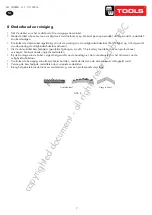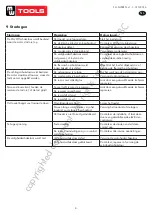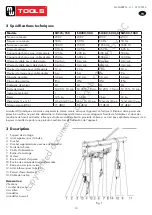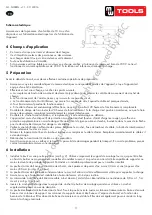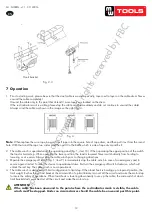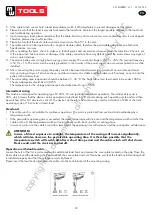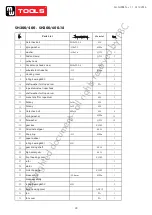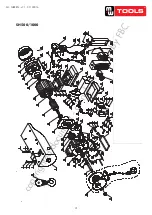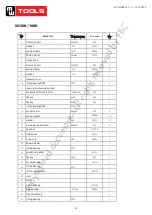
20
SH - NLFREN - v1.1 - 01122016
EN
TOOLS
5. If the cable winch cannot hoist a load immediately, switch it off immediately to prevent damages and accidents.
6. Please be sure that the load is securely fastened to the load hook. Maintain the largest possible distance to the load and
steel cable during operation.
7. Upon lowering a load, please remember that the cable hoist may still unwind a few more centimetres after it was stopped.
Therefore, please stop in sufficient time.
8. Please be sure that the steel cable cannot be moved more than 15° to the side.
9. The cable winch can be operated with a single or double cables, therefore the permissible rated load, see Technical
Specifications, can vary.
10. After unpacking the items, check to make sure that all pieces and accessories correspond with the directions. Check to see
if the rope winch has any dents or damage, if the cable connections have any defects and if the motor shows any signs of
rain or water damage.
11. The electric pulley uses a single-phase energy power supply. The nominal voltage is 230 V + 20%, the nominal frequency
is 50 Hz + 1%. The motor must be safely grounded. In the circuitry of the power supply an over-current protection must be
installed.
12. After connecting the power supply, the pulley can then be raised and lowered in Jog-mode. One can raise and lower
start-up during a dry-run. First when the up and down movement is stable and the brakes work flawlessly, once can test the
pulley with a dummy load.
13. The surrounding area temperature should be between 5 - 40 °C. The height about sea level needs to be under 1000 m.
The area dampness should be at 30-95%.
The temperature for the storage and transport should be about 5 up to 55 °C.
Intermittent rating
This machine is designed for operating type S3 20% - 10 min (periodic intermittent operation). The relative duty cycle is
20%, which means that the device can be operated at rated load for 2.0 minutes during each operating cycle and must then
be switched off for 8.0 minutes to cool off. The device can therefore be continuously used for a duration of 20% of the total
operating cycle of 10 minutes at rated load.
Overload
• The cable winch is not suitable for continuous operation. The motor is protected from overload and overheating by a
temperature switch.
• If the permissible operating time is exceeded, the motor temperature will increase and the temperature switch will shut the
cable winch off. The temperature switch will automatically switch back on after a cooling phase.
• In case of a strain on the cable hoist with a lesser load, the operating time will increase and the cooling time will decrease.
ATTENTION!
In case of direct exposure to sunlight, the temperature of the casing will increase significantly,
which will also decrease the permissible operating time. It is therefore possible that the
temperature switch will switch off after a short time period and the cable winch will shut down.
Please wait until the device is cooled off.
Operation with double cable
Loosen the nuts of the 3 screws located on the additional load hook and remove the cover plate located on the side. Place the
steel cable around the deviating shaft and reattach the cover plate and nuts. Please be sure that the load hook/deviating shaft
is installed properly and that the nuts are securely tightened.
Please insert the load hook attached to the cable into the hook bracket of the mounting casing.
12
temperature
switch will shut
the cable
winch
off. The temperature
switch
w
ill
automatically switch
back
on after a
cooling
phase.
c
)
In case
of a
strain on the cable hoist
with a
lesser load
,
the operating time
will increase and
the
cooling
time
will
decrease
.
d)
Attention! In
case of direct exposure
to
sunlight,
the temperature
of
the
casing will
increase
significantly, which will also
decrease the permissible
operating
time. It is therefore possible that
the temperature
switch will switch
off
after a short
time
period and
the
cable winch will shut
down.
Please
wait
until the device is
cooled off.
Operation
with
double
cable
Loosen the nuts
of
the
3 screws
located
on
the
additional
load hook
(dia.
1, item 4)
and
remove the
cover plate located on the
side.
Place the
steel cable
around the deviating
shaft and
reattach the
cover
plate
and
nuts. Please be
sure
that the load hook
/
deviating
shaft
is installed properly
and
that the nuts
are securely
tightened.
Please insert the load hook (3)
attached
to the
cable
into the hook bracket
of
the mounting
casing
(7).
Maintenance and Cleaning
Disconnect the power plug
prior
to performing any
work
on the device.
Clean the device using
a
damp
cloth
and
some
liquid
soap.
Never use
cleaning agents or solvents,
these
could
damage the device's plastic parts.
Regularly inspect the total length
of
the
steel cable
for damages
as well as
the functionality
of
the
limit
bracket (2)
(Wind
cable winch
until the limit
weight
(5)
activates
the limit bracket
of
the limit
switch).
If the
steel cable
is damaged (split or bent
,
see
dia. below)
,
a
professional must replace it using
original
replacement parts.
During
assembly of
the cable
,
it is imperative to remember the limit
weight (5)
in order to
ensure a
secure
limit
stop.
Inspect the free movement
of
all mechanical
components
after the power plug has been
disconnected.
copyrighted
document
- all
rights
reserved
by
FBC


